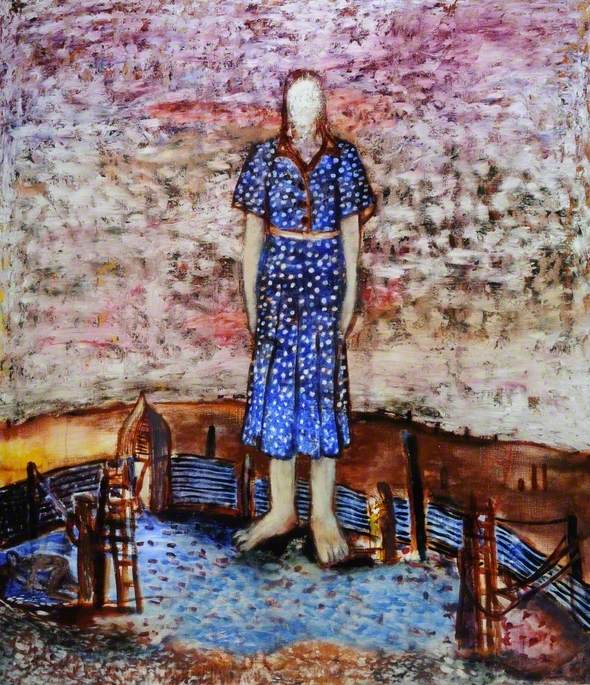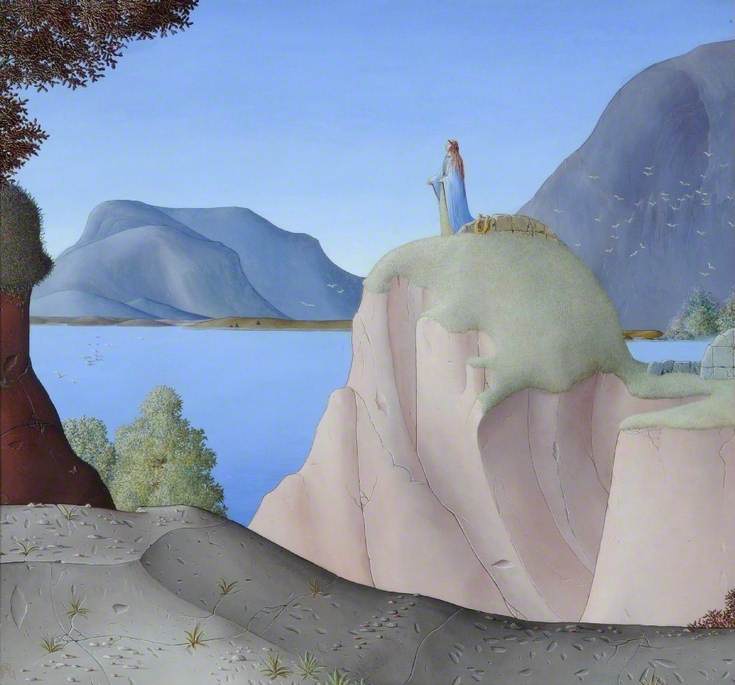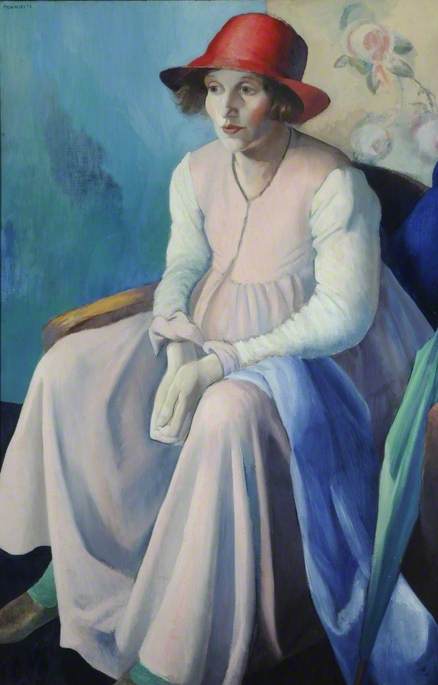Crossing Borders invites viewers to consider the politics of citizenship and national identity within the context of British 20th-century art. The exhibition features the work of British migrant artists who, by choice or necessity, crossed borders to live, work and often nationalise in Britain. By recognising the talent of these artists, Crossing Borders hopes to celebrate the cultural diversity that is inherent in British art’s history, and highlight the positive impact migration and free movement has had historically on the art and culture of Britain.Crossing Borders was exhibited at Ferens Art Gallery from 3 September 2018 – 6 January 2019, and included the powerful projection work 'Veil', 1997, by Jananne Al-Ani (b.1966).
-
Dreaming Earth 1987
Winner of the prestigious first prize in the 17th John Moores Liverpool exhibition, Jackowski is an artist of national importance. Of Polish extraction, he was born in North Wales and now lives in Brighton.
Dreaming Earth is one of a group of large canvasses by the artist devoted to a mysterious female figure lying or standing in a waterside landscape. The atmosphere of the speckled sky, and the roughness of the fairground enclosure, convey the richness of the female presence in the sultry atmosphere and sparse landscape. At the same time, the figure in its enclosure conveys personal isolation. Another critic has suggested that this refers to Jackowski’s childhood in a refugee camp.
Andrzej Jackowski (b.1947)
Oil on canvas
H 152.4 x W 131.7 cm
Ferens Art Gallery
-
Kate Reclining 1949
De Sausmarez was best known as a portrait painter, who exhibited at the Royal Academy, and elsewhere. He was Head of the Fine Art department at Leeds University in the 1950s, and was a friend and teacher of Bridget Riley (b.1931) in the 1960s.
In a letter to the Ferens of 1953 de Sausmarez refers to this work as ‘certainly the best example of my work during the 1950-52 period’. The sitter is the artist’s wife, shown in a formal, almost classical pose.
Although the handling of the paint is rather broad, it also has a certain formality, as the brush-strokes are applied quite deliberately, each one helping to define the structure of the form. The painting shows traces of Sickert’s (1860-1942) long-lasting influence.
Lionel Maurice de Sausmarez (1915–1969)
Oil on canvas
H 45.5 x W 60.8 cm
Ferens Art Gallery
-
Esther Bensusan (1870–1951) 1893
Lucien Pissarro was taught to paint by his father, the famous French Impressionist Camille Pissarro (1831-1903). In France he was in close contact with the artists Paul Cézanne (1839-1906) and Georges Seurat (1859-91) where he was inspired to paint in the pointillist style by applying tiny blobs of paint to create dazzling effects.
Painted a year after their marriage, this portrait is of Pissarro’s wife. In the background is a William Morris (1834-96) tapestry, which combined with Esther’s profile creates a mosaic-like pattern.
Lucien Pissarro (1863–1944)
Oil on canvas
H 40.3 x W 35.5 cm
Ferens Art Gallery
-
Elizabeth Allhusen 1922
French-born Dulac made his reputation as a book illustrator for children’s books such as The Arabian Nights. The subject matter allowed him to indulge in his love of the exotic and the oriental. He went on to enjoy a diverse and very active career, designing stamps, books and gravestones.
With its gold background, oriental details which recall Persian miniature paintings, and hard outlines, this portrait is a 1920s reworking of the great Italian Renaissance portraits by such artists as Titian (c.1487/90-1576) and Leonardo da Vinci (1452-1519).
Edmund Dulac (1882–1953)
Oil & gold paint on canvas on panel
H 48.2 x W 35.5 cm
Ferens Art Gallery
-
Amy Johnson (1903–1941)
Gerrard was born in Antwerp of English parentage. He studied at the Lancaster School of Art and the Royal College of Art. Exhibited at the Royal Academy, NEAC, Redfern Gallery and elsewhere, the City of Birmingham Museum and Art Gallery holds some of his work. He worked abroad, especially in India, where he was an expert in Indian art and iconography.
The famous pilot, Amy Johnson, was born in Hull in 1903. She was the first woman to fly solo 10,000 miles from Surrey to Darwin, Australia in 1930. At the mere age of 26, Amy became the greatest woman pioneer of her generation.
Tragically, she was killed in 1941 when the plane she was piloting crashed into the Thames Estuary. Her body was never recovered.
Charles Gerrard (1892–1964)
Oil on canvas
H 68 x W 57.5 cm
Ferens Art Gallery
-
Sappho 1923
Born into an affluent Hungarian-Jewish family, Lowinsky is best known as a book illustrator, connoisseur and collector. He liked to paint detailed imaginative compositions inspired by the Bible, or as here, classical mythology.
There is a surreal, ambiguous quality to much of his work, though his vibrantly coloured tempera painting technique draws on the artistic traditions of Northern Italy.
The subject of the picture, Sappho, was a Greek lyric poet, born c.621 BC who became head of a small college of women in her native island of Lesbos (the origin of the term lesbian). Legend has it that she threw herself off a cliff because of unrequited love. Lowinsky’s dream-like scene depicts the moment before Sappho falls to her death.
Thomas Esmond Lowinsky (1892–1947)
Oil on canvas
H 47.8 x W 51.5 cm
Ferens Art Gallery
-
San Justo, Toledo, Spain 1929
Bomberg was the fifth child of Polish-Jewish immigrants. Early in his artistic career he was attracted to the dynamism of the Vorticists, although he was never a member. However, after World War I he grew further and further away from their harsh, semi-abstract style.
In the 1920s Bomberg moved to a more figurative style and his work became increasingly dominated by portraits and landscapes drawn from nature. He gradually developed a more expressionist technique and travelled widely through the Middle East and Europe.
He painted in Palestine between 1923 and 1927 and from there followed his great period of painting and drawing of the Spanish landscape, such as this painting made following a spell in Toledo in 1928.
David Bomberg (1890–1957)
Oil on canvas
H 50.8 x W 66 cm
Ferens Art Gallery
-
Derelict Lead Mine 1940s
Hillier’s artistic development fell into three phases: abstract pictures produced as a young man in Paris, followed by a long period of Surrealist painting, and, from 1938, much more representational work. The distinctive style which he evolved as a Surrealist permeated all his later work.
In Derelict Lead Mine the deep shadows, the eerie forms of the trees, and the melancholy of the ruined, overgrown buildings and deserted landscape lend to the work the haunting quality of a dream or of a wartime bomb site. There are old lead mines on the moors near Priddy in Somerset, which are presumably the subject of this painting.
Tristram Paul Hillier (1905–1983)
Oil on canvas
H 60 x W 81 cm
Ferens Art Gallery
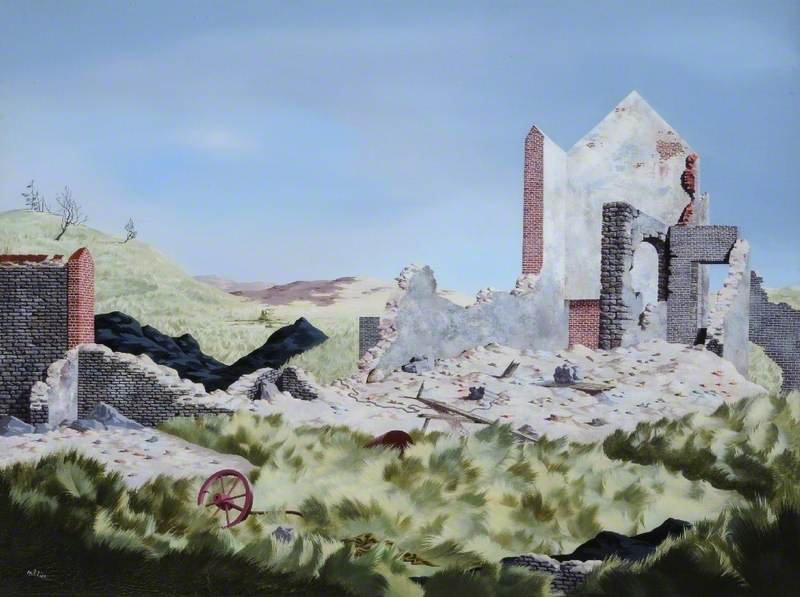 © the artist's estate / Bridgeman Images. Image credit: Ferens Art Gallery
© the artist's estate / Bridgeman Images. Image credit: Ferens Art Gallery
-
Girl in Grey 1919
Born in Leeds of Russian parents, Naviasky attended the Royal College of Art in London. He worked widely in Yorkshire as well as abroad in Spain, the South of France, Morocco and elsewhere. He was best known for his portraits of women and children and was also noted for his skills as a draughtsman.
Girl in Grey typifies much of his work, with its simple pose, muted, harmonious colours and suppression of irrelevant detail. In this respect he shows the influence of Whistler (1834-1903). The identity of the sitter is unknown.
Naviasky was forced to stop painting in the late 1960s due to failing sight.
Philip Naviasky (1894–1983)
Oil on canvas
H 56.5 x W 44.5 cm
Ferens Art Gallery
-
Self Portrait Looking Up 1982
Leon Kossoff is a British expressionist painter, known for portraits, life drawings and cityscapes of London. He developed a technique of dripping trails of paint over a basic outline. In this painting the bone structure of the face is evident beneath expressionistic brush strokes. This hints at an awareness of the skull, a symbol of human mortality.
Born in London of Russian-Jewish parentage, Kossoff attended St. Martin’s School of Art. Like his contemporary Frank Auerbach (b.1931) he was influenced by their tutor David Bomberg (1890-1957), another Jewish émigré. During the 1980s Kossoff’s work became increasingly contemplative, intense and emotive. He is regarded as one of Britain’s leading artists.
Leon Kossoff (1926–2019)
Oil on canvas
H 61 x W 46.4 cm
Ferens Art Gallery
-
Pelago, Italy c.1896
The painting shows a large crowd of people participating in a communal baptism.
Brangwyn produced at least 20 images of the city of Pelago in various media and it is not known when exactly he painted this image. However the screen of attenuated trees on the left was a frequent device in Brangwyn’s paintings in the 1890s.
Born in Bruges, Brangwyn was a fine draughtsman as well as a skilled etcher and lithographer. An official War artist, Brangwyn became a prolific poster-maker and used this propaganda to support Belgian refugees seeking sanctuary in Britain.
Frank Brangwyn (1867–1956)
Tempera on paper
H 106.5 x W 117 cm
Ferens Art Gallery
 © the artist's estate / Bridgeman Images. Image credit: Ferens Art Gallery
© the artist's estate / Bridgeman Images. Image credit: Ferens Art Gallery
-
The Red Hat (Margaret Meninsky) 1919
Part of a generation of Anglo-Jewish painters, Meninsky was born in the Ukraine shortly before his family immigrated to Britain. Meninsky became interested in art while studying accountancy in Liverpool and, by 1914, was exhibiting in London with the New English Art Club.
In the early 1920s he completed a series of studies of mother and child subjects. His rounded, solid figures of this period compare with those of Jacob Kramer (1892-1962) and William Roberts (1895-1980).
The portrait shows Margaret O’Connor, Meninsky’s first wife, when she was pregnant with their second son. It is lent poignancy by the fact that Margaret died only two years after this painting was made.
Bernard Meninsky (1891–1950)
Oil on canvas
H 114.2 x W 76.2 cm
Ferens Art Gallery
-
Galway Harbour, Ireland 1947
A central figure in the British Surrealist movement of the 1930s, Hillier’s painting became more romantic and representational in the post-war era. Much misunderstood, Hillier’s change of style was regarded as a betrayal of ideals by members of the avant-garde.
Hillier’s paintings have an enigmatic, arresting quality. Typical of the artist’s later work, Galway Harbour, with its elaborate dock machinery and jetties, is eerily quiet and remote. Surprising for a bustling harbour, the scene is devoid of any activity except for the horse and cart and tiny figures on the dockside in the distance.
Tristram Paul Hillier (1905–1983)
Oil on canvas
H 61 x W 81 cm
Ferens Art Gallery
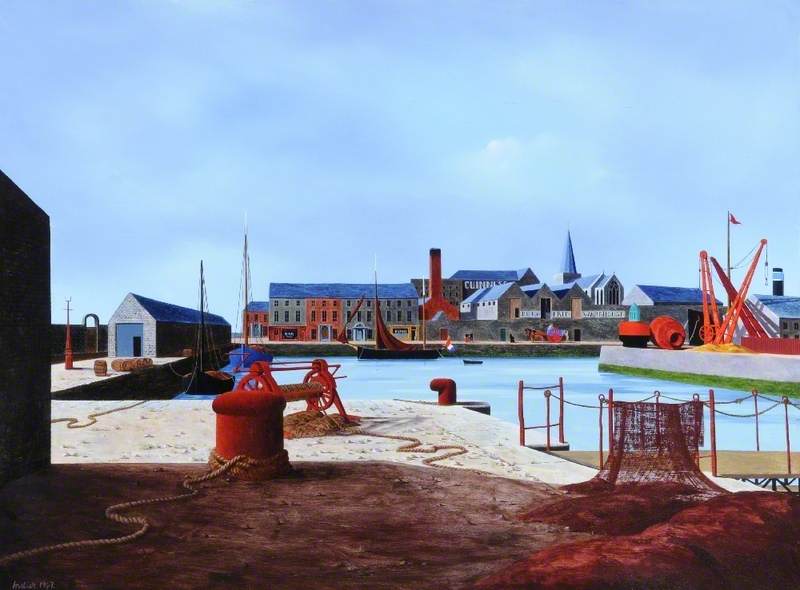 © the artist's estate / Bridgeman Images. Image credit: Ferens Art Gallery
© the artist's estate / Bridgeman Images. Image credit: Ferens Art Gallery
-
Santa Maria della Salute, Venice (Venetian Anchors) (The Salute, Venice) c.1906 (repainted 1933)
The painting shows a large crowd of people participating in a communal baptism.
Brangwyn produced at least 20 images of the city of Pelago in various media and it is not known when exactly he painted this image. However the screen of attenuated trees on the left was a frequent device in Brangwyn’s paintings in the 1890s.
Born in Bruges, Brangwyn was a fine draughtsman as well as a skilled etcher and lithographer. An official War artist, Brangwyn became a prolific poster-maker and used this propaganda to support Belgian refugees seeking sanctuary in Britain.
Frank Brangwyn (1867–1956)
Oil on canvas
H 147.5 x W 160 cm
Ferens Art Gallery
 © the artist's estate / Bridgeman Images. Image credit: Ferens Art Gallery
© the artist's estate / Bridgeman Images. Image credit: Ferens Art Gallery
-
The Cossack Hat c.1911
Wolmark’s family came to England in 1883 and settled in London’s East End. His early work showed Jewish life there, but after a visit to France in 1911 he became an early advocate of Post Impressionism. His paintings from 1911 to the mid-1920s are experimental and brilliantly coloured.
Anna Wimersdoerffer (1859-1919), Wolmark’s friend and sponsor is the subject of his daringly vibrant portrait. During this period Wolmark excelled in placing forms against strongly coloured backgrounds; however, his sitters still stand out as his figure painting is so dramatic. According to photographs this is an extremely good likeness of the sitter, not at all obscured by the heavy brushstrokes or the stylisation.
Alfred Aaron Wolmark (1877–1961)
Oil on canvas
H 201 x W 135 cm
Ferens Art Gallery
-
Study of a Ballet Girl Preparing for a Rehearsal 1930
Kramer’s family came from the Ukraine and settled in Leeds in 1900. Like many other Anglo-Jewish artists of the time, his early art studies were funded by the Jewish Educational Aid Society.
Study for Ballet Girl is less geometric in style than the Ferens’ earlier Kramer painting, The Rabbis. The figure of the dancer also has a greater solidity, emphasised by a strong light-dark contrast.
Kramer was a frequent visitor to the Grand Theatre in Leeds, where he made studies of the ballet dancers preparing for their performances.
Jacob Kramer (1892–1962)
Oil on canvas
H 91.8 x W 71.4 cm
Ferens Art Gallery
-
The Rabbis c.1919
Kramer’s family came from the Ukraine and settled in Leeds in 1900. Like many other Anglo-Jewish artists of the time, such as Bomberg (1890-1957), his early art studies were funded by the Jewish Educational Aid Society. From 1912 he was enrolled at the Slade School of Art.
He developed a simple, geometric style derived from a mixture of influences, including the angular cubism of the Spaniard Picasso (1881-1973), and the semi-abstract work of the Vorticists, of which Wyndham Lewis’s (1882-1957) Tyro is a superb example. The Rabbis evokes the character and atmosphere of Jewish tradition, Kramer’s familiar background.
Jacob Kramer (1892–1962)
Oil on canvas
H 76.5 x W 50.8 cm
Ferens Art Gallery
Explore artists in this Curation
View all 14-
 Lionel Maurice de Sausmarez (1915–1969)
Lionel Maurice de Sausmarez (1915–1969) -
 Bernard Meninsky (1891–1950)
Bernard Meninsky (1891–1950) -
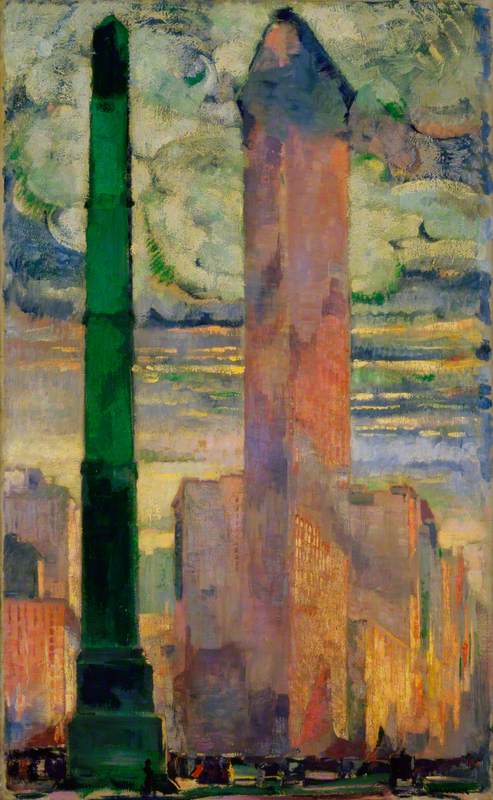 Alfred Aaron Wolmark (1877–1961)
Alfred Aaron Wolmark (1877–1961) -
 Tristram Paul Hillier (1905–1983)
Tristram Paul Hillier (1905–1983) -
 Frank Brangwyn (1867–1956)
Frank Brangwyn (1867–1956) -
 Lucien Pissarro (1863–1944)
Lucien Pissarro (1863–1944) -
 Philip Naviasky (1894–1983)
Philip Naviasky (1894–1983) -
 Andrzej Jackowski (b.1947)
Andrzej Jackowski (b.1947) -
 Leon Kossoff (1926–2019)
Leon Kossoff (1926–2019) -
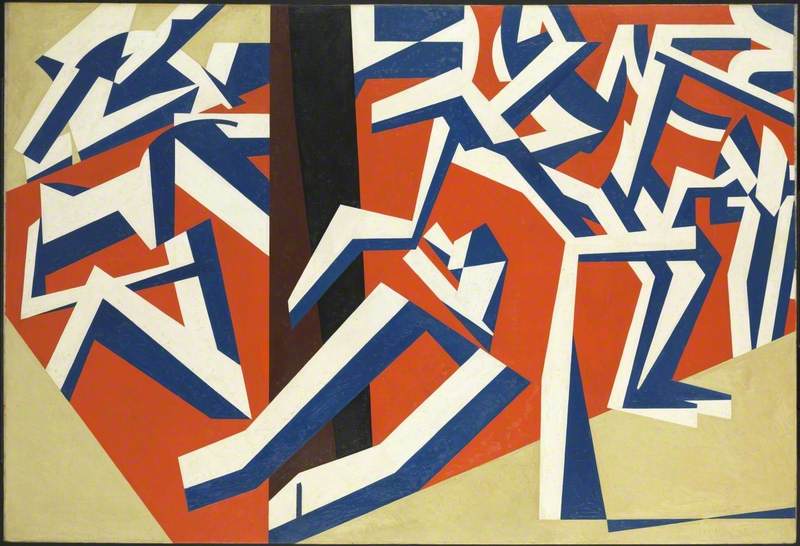 David Bomberg (1890–1957)
David Bomberg (1890–1957) - View all 14
